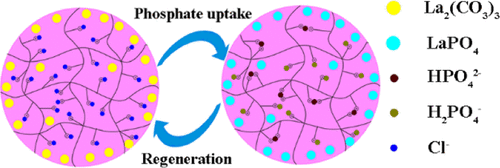当前位置:
X-MOL 学术
›
J. Chem. Eng. Data
›
论文详情
Our official English website, www.x-mol.net, welcomes your
feedback! (Note: you will need to create a separate account there.)
Nanoscale Lanthanum Carbonate Hybridized with Polyacrylic Resin for Enhanced Phosphate Removal from Secondary Effluent
Journal of Chemical & Engineering Data ( IF 2.0 ) Pub Date : 2020-08-21 , DOI: 10.1021/acs.jced.0c00352 Yue Sun 1 , Xinlei Feng 1 , Weisheng Zheng 1
Journal of Chemical & Engineering Data ( IF 2.0 ) Pub Date : 2020-08-21 , DOI: 10.1021/acs.jced.0c00352 Yue Sun 1 , Xinlei Feng 1 , Weisheng Zheng 1
Affiliation

|
The removal of phosphate from water has attracted increasing attention because of the dominant role of phosphate in eutrophication. In this study, a novel nanoscale hybridized adsorbent, NLC@213, was fabricated by immobilizing nanosized lanthanum carbonate (NLC) into the pores of the macro-porous polyacrylic anion exchanger D213 through an in-situ precipitation method for phosphate adsorption from wastewater. NLC@213 exhibited excellent pH tolerance and possessed a high selectivity for phosphate in the presence of competing anions (Cl–, NO3–, SO42–, SiO32–, and HCO32–) and organic acids (humic, tannic, and gallic acids). The maximum phosphate adsorption capacity reached 53.64 mg P/g at 30 °C. Moreover, fixed-bed column adsorption experiments demonstrated that NLC@213 could effectively treat 2400 bed volumes of real secondary effluent (phosphate concentration decreased from 2.0 to <0.5 mg P/L). The exhausted NLC@213 could be regenerated easily using a binary solution of NaCl (1.5 mol/L)–Na2CO3 (3 mol/L), and no significant capacity loss was observed during the recycling for column adsorption–desorption. The underlying mechanism of phosphate adsorption was investigated by a combination of Fourier-transform infrared, transmission electron microscopy, and X-ray photoelectron spectroscopy, and the formation of LaPO4·xH2O was suggested to be the main pathway in the separation process of phosphate from real secondary effluent.
中文翻译:

纳米级碳酸镧与聚丙烯树脂杂化以增强二级废水的除磷效果
由于磷酸盐在富营养化中的主要作用,因此从水中去除磷酸盐已引起越来越多的关注。在这项研究中,通过原位沉淀法将纳米碳酸镧(NLC)固定在大孔聚丙烯酸阴离子交换剂D213的孔中,制备了一种新型的纳米级杂化吸附剂NLC @ 213,用于废水中磷酸盐的吸附。NLC @ 213表现出出色的pH耐受性,并且在存在竞争性阴离子(Cl –,NO 3 –,SO 4 2–,SiO 3 2–和HCO 3 2–)和有机酸(腐殖酸,单宁酸和没食子酸)。在30°C下,最大磷酸盐吸附容量达到53.64 mg P / g。此外,固定床柱吸附实验表明,NLC @ 213可以有效处理2400床体积的实际二级废水(磷酸盐浓度从2.0降至<0.5 mg P / L)。用NaCl(1.5 mol / L)–Na 2 CO 3(3 mol / L)的二元溶液可以很容易地再生耗尽的NLC @ 213 ,并且在回收柱吸附-解吸过程中没有观察到明显的容量损失。结合傅立叶变换红外光谱,透射电子显微镜和X射线光电子能谱研究了磷酸盐吸附的潜在机理,以及LaPO 4 ·的形成。x H 2 O被认为是从真正的次级废水中分离磷酸盐的主要途径。
更新日期:2020-08-21
中文翻译:

纳米级碳酸镧与聚丙烯树脂杂化以增强二级废水的除磷效果
由于磷酸盐在富营养化中的主要作用,因此从水中去除磷酸盐已引起越来越多的关注。在这项研究中,通过原位沉淀法将纳米碳酸镧(NLC)固定在大孔聚丙烯酸阴离子交换剂D213的孔中,制备了一种新型的纳米级杂化吸附剂NLC @ 213,用于废水中磷酸盐的吸附。NLC @ 213表现出出色的pH耐受性,并且在存在竞争性阴离子(Cl –,NO 3 –,SO 4 2–,SiO 3 2–和HCO 3 2–)和有机酸(腐殖酸,单宁酸和没食子酸)。在30°C下,最大磷酸盐吸附容量达到53.64 mg P / g。此外,固定床柱吸附实验表明,NLC @ 213可以有效处理2400床体积的实际二级废水(磷酸盐浓度从2.0降至<0.5 mg P / L)。用NaCl(1.5 mol / L)–Na 2 CO 3(3 mol / L)的二元溶液可以很容易地再生耗尽的NLC @ 213 ,并且在回收柱吸附-解吸过程中没有观察到明显的容量损失。结合傅立叶变换红外光谱,透射电子显微镜和X射线光电子能谱研究了磷酸盐吸附的潜在机理,以及LaPO 4 ·的形成。x H 2 O被认为是从真正的次级废水中分离磷酸盐的主要途径。











































 京公网安备 11010802027423号
京公网安备 11010802027423号